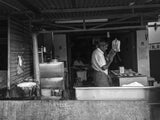Sikh drivers are changing the landscape of U.S. trucking
Take a ride along the Punjabi American highway.
There are 3.5 million truckers in the United States. California has the second-most after Texas. As drivers age toward retirement and a shortage grows, Sikh immigrants and their kids are increasingly taking up the job.
 Palwinder Singh hauls produce through New Mexico on Interstate 40 on the way to Indiana. (Irfan Khan / Los Angeles Times)
Palwinder Singh hauls produce through New Mexico on Interstate 40 on the way to Indiana. (Irfan Khan / Los Angeles Times)
MILAN, N.M. — It’s 7:20 p.m. when he rolls into Spicy Bite, one of the newest restaurants here in rural northwest New Mexico. Locals in Milan, a town of 3,321, have barely heard of it. The building is small, single-story, built of corrugated metal sheets. There are seats for 20. The only advertising is spray-painted on concrete roadblocks in English and Punjabi. Next door is a diner and gas station; the county jail is across the road.



Top, Singh waits for his turn to receive a load of produce at JBJ Distributing in Fullerton. Bottom, Singh checks his truck before getting on the road for a weeklong trip to Indiana to deliver fresh produce from California. (Irfan Khan / Los Angeles Times)
The best-known are along Interstate 40, which stretches from Barstow to North Carolina. The road, much of it alongside Historic Route 66, forms the backbone of the Sikh trucking world.
It’s a route that Pal, 38, knows well. Three times a month, he makes the seven-day round trip between his Fontana home and Indiana, where he drops off loads and picks up new ones. Over his career, he’s driven 2 million miles and transported items as varied as frozen chickens and paper plates. These days, he mostly hauls chocolate, rice and fruits and vegetables from California farms. Today, it’s 103 containers of mixed produce, with mangoes, bell peppers, watermelons, yellow onions and peeled garlic among them. All are bound for a Kroger warehouse outside Indianapolis.
Across the street from Spicy Bite, dozens of arriving drivers form a temporary village of 18-wheelers in a vast parking lot by the interstate. Most are white. Nearly all are men. More are older than younger. But every now and then there are Sikhs like Pal, with long salt-and-pepper beards, colorful turbans and thick Indian accents. They head straight toward Spicy Bite. Lines can form out the door at the restaurant, which opened two years ago outside the Petro Stopping Center, a longtime mainstay for truckers headed east.
‘When I’m driving, I see God through his creation.’
Palwinder Singh, who is in his 15th year of trucking
Pal makes a point to stop by the restaurant — even just for a “hello” — when he sleeps next door. The Sikh greeting is “Sat sri akaal.” It means “God is truth.” In trucking, where turnover is high, business uncertain and risk of accidents ever present, each day can feel like a leap of faith and an opportunity to give thanks.
Punjabi Americans first appeared on the U.S. trucking scene in the 1980s after an anti-Sikh massacre in India left thousands dead around New Delhi, prompting many Sikhs to flee. More recently, Sikhs have migrated to Central America and applied for asylum at the Mexico border, citing persecution for their religion in India; some have also become truckers. Estimates of the overall U.S. Sikh population vary, placing the community’s size between 200,000 and 500,000.
In recent years, corporations have pleaded for new truckers. Walmart kicked up salaries to attract drivers. Last year, the government announced a pilot program to lower the age for driving trucks from 21 to 18 for those with truck-driving training in the military. According to the American Trucking Assn., the trucker shortage could reach 100,000 within years.
“Punjabis are filling the gap,” says Raman Dhillon, a former driver who last year founded the North American Punjabi Trucking Assn. The Fresno-based group advises drivers on regulations, offers insurance and tire discounts, and runs a magazine: Punjabi Trucking.



 Top to bottom: A sign is spray-painted on a concrete roadblock outside Spicy Bite in Milan, N.M.; Palwinder Singh prays inside his cab before leaving New Mexico for Oklahoma; at Spicy Bite, he dines on familiar foods. Singh prepares to shower at a truck stop in Milan; (Irfan Khan / Los Angeles Times)
Top to bottom: A sign is spray-painted on a concrete roadblock outside Spicy Bite in Milan, N.M.; Palwinder Singh prays inside his cab before leaving New Mexico for Oklahoma; at Spicy Bite, he dines on familiar foods. Singh prepares to shower at a truck stop in Milan; (Irfan Khan / Los Angeles Times)
Like trucking itself, where the threat of automation and the long hours away from home have made it hard to recruit drivers, the Punjabi trucking life isn’t always an easy sell. Three years ago, a group of Sikh truckers in California won a settlement from a national shipping company after saying it discriminated against their faith. The drivers, who followed Sikh traditions by wrapping their uncut hair in turbans, said bosses asked them to remove the turbans before providing hair and urine samples for pre-employment drug tests despite being told of the religious observance. The same year, police charged a man with vandalizing a semi truck at a Sikh temple in Buena Park. He’d scribbled the word “ISIS.”
Still, Hindi- and Punjabi-language newspapers in the Eastern U.S. regularly run ads promising better wages, a more relaxed lifestyle and warm weather as a trucker out West. Talk to any group of Sikh drivers and you’ll find former cabbies, liquor store workers or convenience store cashiers who made the switch.
“Thirty years ago, it was hard to get into trucking because there were so few people like us in the business who could help you,” says Rashpal Dhindsa, a former trucker who runs Fontana-based Dhindsa Group of Companies, one of the oldest Sikh-owned U.S. trucking companies. When Pal first started, Dhindsa — now a close friend but then an acquaintance — gave him a $1,000 loan to cover training classes.
It’s 6:36 a.m. the next day when the Petro Stopping Center switches from quiet darkness to rumbling engines. Pal flips on the headlights of his truck, a silver ’16 Volvo with a 500-horsepower engine. Inside the rig, he heats aloo gobi — spiced potatoes and cauliflower — that his wife prepared back home. He checks the thermostat to make sure his trailer isn’t too warm. He takes out a book wrapped in a blue cotton cloth that’s tucked by his driver’s seat, sits on a bed-turned-couch and reads a prayer in Punjabi for safety on the journey: There is only one God. Truth is His name…. You always protect us.
He pulls east onto the highway as the sun rises.

Singh takes a break in New Mexico on his way to Indiana. (Irfan Khan / Los Angeles Times)
Truckers either drive in pairs or solo like Pal. Either way, it’s a quiet, lonely world.
Still, Pal sees more of America in a week than some people will in their lives. Rolling California hills, spiky desert rock formations, the snow-dusted evergreens of northern Arizona, the fuzzy cacti in New Mexico and, in Albuquerque, hot air balloons rising over an orange sky. There’s also the seemingly endless fast food and Tex-Mex of Amarillo and the 19-story cross of Groom, Texas. There’s the traffic in Missouri. After hours of solitude on the road, it excites him.
Pal’s not strict on dogma or doctrine, and he’s more spiritual than religious. Trucking has shown him that people are more similar than different no matter where you go. The best of all religions, he says, tend to teach the same thing — kindness to others, accepting whatever comes your way and appreciation for what’s in front of you on the road.
“When I’m driving,” Pal says, “I see God through his creation.”
His favorite sights are the farms. You spot them in Central California while picking up pallets of potatoes and berries, or in Illinois and Indiana while driving through the corn and soybean fields.They remind him of home, the rural outskirts of Patiala, India.
Nobody in his family drove trucks. Still, to Pal, he’s continuing tradition. His father farmed potatoes, cauliflower, rice and tomatoes. As a child, Pal would ride tractors for fun with Dad. Today, instead of growing food, Pal transports it.
He wasn’t always a trucker. After immigrating in 2001 with his younger brother, he settled in Canoga Park and worked nights at 7-Eleven. After he was robbed at gunpoint, a friend suggested trucking. Better pay, flexible hours — and less dangerous.


Top, Singh says goodbye to his wife, Harjeet Kaur, as he leaves for Indiana. Bottom, Singh comforts his 4-year-old son, Devjot Kamboj, who was saddened to learn his dad had another cross-country delivery to make. (Irfan Khan / Los Angeles Times)
Three years later, he started driving a rig he didn’t own while getting paid per mile. Today, he has his own company, two trucks between himself and his brother — also a driver — and bids on shipments directly with suppliers. Nationally, the average pay for a trucker is just above $43,000. Pal makes more than twice that.
He uses the money to pay for the house he shares with his wife, Harjeet Kaur, 4-year-old son, brother and sister-in-law, nieces and parents. Kaur threads eyebrows at a salon and video chats with him during lunch breaks. Every week before he leaves, she packs a duffel bag of his ironed clothes and stacked containers of food for the road.
“I love it,” Pal says about driving. “But there are always two sides of the coin, head and tail. If you love it, then you have to sacrifice everything. I have to stay away from home. But the thing is, this job pays me good.”
The truck is fully equipped. From the road, you can see only driver and passenger seats. But behind them is a sleeper cab with a bed that’s 6-foot-7 by 3-foot-2.
Pal likes to connect the TV sitting atop a mini-fridge to his phone to stream music videos when he’s alone. His favorite songs are by Sharry Maan, an Indian singer who topped charts two years ago with 'Transportiye' It tells the story of a Sikh American trucker who longs for his wife while on the road. At night, the table folds down to become a bed. Pal is just missing a bathroom and his family.

Singh prays at home before taking off for a long drive. Irfan Khan / Los Angeles Times
The life of a Sikh trucker is one of contrasts. On one hand, you see the diversity of America. You encounter new immigrants from around the world working the same job as people who have been truckers for decades. All transport the food, paper and plastic that make the country run. But you also see the relics of the past and the reminders of how you, as a Sikh in 2019, still don’t entirely fit in.
It’s 9:40 a.m. on Saturday when Pal pulls into Bowlin’s Flying C Ranch rest center in Encino, N.M., an hour past Albuquerque and two from Texas. Here, you can buy a $19,999 stuffed buffalo, Baja jackets and fake Native American moccasins made in China in a vast tourist stop attached to a Dairy Queen and an Exxon. “God Bless the U.S.A.” by Lee Greenwood plays in the background.
It reminds Pal of the time he was paying his bill at another gas station. A man suddenly shouted at customers to “get out, he’s going to blow up this place!” “I will not fight you,” Pal calmly replied. The man left. Those kinds of instances are rare, but Pal always senses their danger. Some of the most violent attacks on Sikhs this century have been at the hands of people who mistook them for Muslims or Arabs, including the case of a turban-wearing Sikh man in Arizona who was shot dead by a gunman four days after the Sept. 11 attacks.
‘You used see a guy with a turban and you would get excited. Today, you go to some stops and can convince yourself you are in India.’
For Pal, suspicious glances are more common. So are the truckers who think he’s new to the business or doesn't speak English. None of it fazes him.“Everybody relates to us through Osama bin Laden because we look the same,” he says, driving across the plains toward the Texas Panhandle. “Or they think because my English sounds different that I am not smart. I know who I am.”
Every day, he wears a silver bracelet that symbolizes a handcuff. “Remember, you are handcuffed to God. Remind yourself to not do bad things,” Pal says. It reminds him to be kind in the face of ignorance and hatred.
At a Subway in Amarillo a few hours later, he grabs his go-to lunch when he’s taking a break from Indian food: a chicken sandwich on white bread with pepper jack, lettuce, tomato and onion. At home, the family is vegetarian. Pal relishes chances on the road to indulge in meat. He used to depend solely on his wife’s cooking. Today, he has other options. It’s a luxury to switch from homemade meals to Punjabi restaurants to fast food.



 Clockwise from top left: Sikh priests lead a Nagar Kirtan parade followed by a truck out of Palwinder Singh's temple in Jurupa Valley; Pritam Singh, who also works for a trucking company, attends the festivities; Baljit Singh, who has been driving trucks for 30 years, at Nagar Kirtan festivities and Ekamjit Sandhu sits in his uncle's truck. (Irfan Khan / Los Angeles Times)
Clockwise from top left: Sikh priests lead a Nagar Kirtan parade followed by a truck out of Palwinder Singh's temple in Jurupa Valley; Pritam Singh, who also works for a trucking company, attends the festivities; Baljit Singh, who has been driving trucks for 30 years, at Nagar Kirtan festivities and Ekamjit Sandhu sits in his uncle's truck. (Irfan Khan / Los Angeles Times)
Trucking has helped Pal find his faith. When he moved to the U.S., he used to shave, drink beer and not care much about religion. But as he got bored on the road, he started listening to religious sermons. Twelve years ago, he began to again grow his hair and quit alcohol; drinking it is against the faith’s traditions. Today, he schedules shipments around the temple calendar so he can attend Sikh celebrations with his family.
“I don’t mind questions about my religion. But when people say to me, ‘Why do you not cut your hair?’ they are asking the wrong question,” Pal says. “The real question is, why do they cut their hair? God made us this way.”
It’s 4:59 p.m. when he arrives in Sayre, Okla., at Truck Stop 40. A yellow Punjabi-language billboard advertises it as the I-40 starts to bend north in a rural region two hours from Oklahoma City.

Singh arrives near sunset at Truck Stop 40, one of the largest Sikh-run rest stops, in Sayre Okla. (Irfan Khan / Los Angeles Times)
Among the oldest Sikh truck stops, it has a 24-hour vegetarian restaurant, convenience store, gas station and a housing trailer that functions as a temple — all spread over several acres.
Pal has been coming here for more than decade, since it was a mechanic shop run by a Sikh former trucker who settled on the plot for its cheap land. When he has time, Pal lingers for a meal. But he’s in a rush to get to Joplin, Mo., for the night so he can make his drop-off the next day.
He grabs a chai and heads to the temple. Resting on a small pillow upon the altar is the Guru Granth Sahib, the Sikh holy book. An audiotape plays prayers on a loop. A print of Guru Nanak, the faith’s founder, hangs on the wall.
Pal prostrates and leaves a few dollar bills on the floor as a donation for upkeep. He prays for God to protect the temple, his family and himself on the 891 miles that remain until he hits the Indianapolis suburbs.
“This feels like a long drive,” Pal says. “But it’s just a small part of the journey of life.”



